
Dohány Street Synagogue - Budapest
|
Wikipedia: "In 1944, the Dohány Street Synagogue was part of the Jewish Ghetto for the city Jews and served as shelter for many hundreds. Over two thousand of those who died in the ghetto from hunger and cold during the winter 1944-1945 are buried in the courtyard of the synagogue.
"It is not customary to have a cemetery next to a synagogue, and the establishment of the 3,000 square meter cemetery was only the result of historical circumstances. In 1944, as a part of the Eichmann-plan, 70,000 Jews were relocated to the Ghetto of Pest. Until 18 January 1945, when the Russians liberated the ghetto, around 8,000 to 10,000 people had died, although, one part of the deceased were transferred to the Kozma Street Cemetery, but 2,000 people were buried in the makeshift cemetery. In memory of those who had died, there is a memorial by the sculptor, Imre Varga, depicting a weeping willow with the names and tattoo numbers of the dead and disappeared just behind the Synagogue, in the Raoul Wallenberg Holocaust Memorial Park. "The Raoul Wallenberg Emlékpark (memory park) in the rear courtyard holds the Memorial of the Hungarian Jewish Martyrs — at least 400,000 Hungarian Jews were murdered by the Nazis. Made by Imre Varga, it resembles a weeping willow whose leaves bear inscriptions with the names of victims. There is also a memorial to Wallenberg and other Righteous Among the Nations, among them: Swiss Vice-consul Carl Lutz; Giorgio Perlasca, an Italian man who, with a strategic escamotage, declared himself the Spanish consul, releasing documents of protection and current passports to Jews in Budapest without distinction (he saved five thousand); Mons. Angelo Rotta, an Italian Prelate Bishop and Apostolic Nuncio of the State of Vatican City in Budapest, which issued protective sheets, misrepresentations of baptism (to save them from forced labor) and Vatican passports to Jews, without distinction of any kind present in Budapest (saving fifteen thousand), who saved, with his secretary Mons. Gennaro Verolino tens of thousands of Hungarian Jews during World War II. Carlos de Liz-Texeira Branquinho a Portuguese diplomat, serving as Portugal’s Chargé d'Affaires in Budapest in 1944, issued protective Passports to hundreds of Jewish families, altogether about 1,000 lives were saved due to his actions. Carlos Sampaio Garrido the Portuguese Ambassador who resisted the Hungarian political police when the police raided his home arresting his guests. The Ambassador physically resisted the police and was also arrested but managed to have his guests released by invoking the extraterritorial legal rights of diplomatic legations; five of the guests were members of the famous Gabor family." |